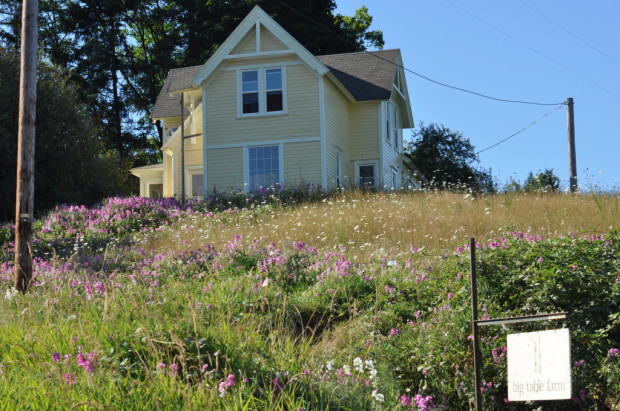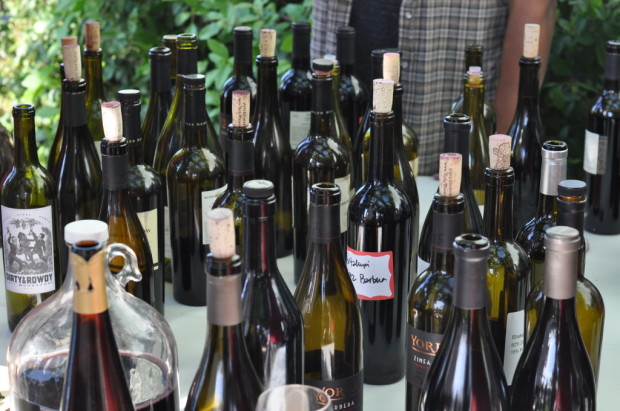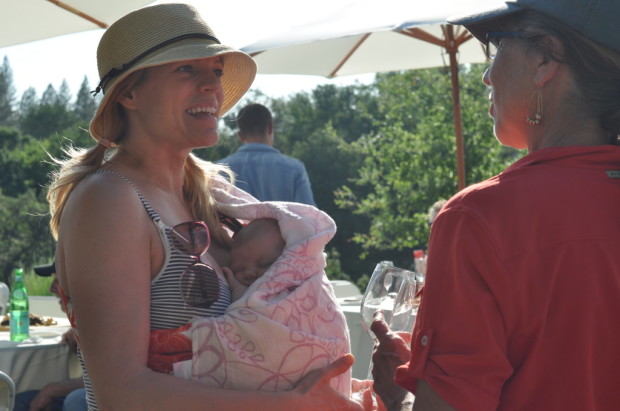Thank you to Eric Asimov for recommending this post in the Friday, June 21, 2013 edition of The New York Times Diner’s Journal “What We’re Reading.”
***
The History of Smith-Madrone
Stu Smith inspecting Chardonnay, April 2013
Smith-Madrone began on a Santa Monica beach at the end of the 1960s, where two brothers, Charles and Stu Smith, grew up. It was a time when an otherwise middle class family could afford vineyard land in Napa Valley, and start a winery fresh becoming owners that produce their own wine, a phenomenon rare in the region today.
Stu Smith worked as a summer lifeguard while completing a degree in Economics at SF State. His brother, Charles, earned his undergraduate at the same institution with a focus on English Literature, also taking a lot of Philosophy classes.
In the midst of his undergrad, Stu developed the idea of studying viticulture, and buying land in the Napa Valley to grow wine. While defending swimmers, he got to know a beach regular that expressed interest in the vineyard idea, offering to help with the purchase. Though the man ultimately had no connection to the future of Smith-Madrone, never paying for any property, the suggestion of a potential investor gave Smith the gumption to move north and begin looking.
In Fall of 1970, then, Stu Smith began the Masters program at UC Davis, while also seriously looking for land. Charles had an interest in wine as well, and so began commuting to Davis, sitting in on Stu’s courses. Though Charles was never enrolled in the program, he completed a portion of the training alongside his brother.
Spring Mountain was largely undeveloped in the early 1970s. As Stu describes it, the hillside was covered in trees, mainly Douglas Fir at least 2 1/2 feet in diameter. “The land was completely over grown, but it had lots of good aspects for sun, and obviously had good soils.” Stony Hill Winery had established itself a little down the mountain from what is now Smith-Madrone, so he had a sense the region could support vines. Then, while hiking the forested property he looked down and found old grape stakes there on the forest floor. The hill had once been planted to vineyard. Though the original investor fell through, in 1971, Stu gathered support from a small group of family and friends to purchase and start what would become 38 vineyard acres.
2007 Cook’s Flat Reserve, Smith-Madrone’s inaugural reserve wine
The brothers now know their hillside property had been planted entirely in vines in the 1880s. The original deed, signed under then president Chester A. Arthur, establishes George Cook as owner on December 5, 1884. Prohibition would later end the life of the Cook Vineyard, but on December 5, 1933, the anniversary of Cook’s purchase, the Volstead Act would overturn Prohibition. In the midst of Prohibition, however, the property returned to forest until Smith-Madrone began. Though Stu instigated the project, thanks to its size and mutual interest, Charles became part of it within a year. Today, as the brothers describe, Stu manages everything outside, while Charles takes care of everything inside. The two are the sole full-time employees of their 5000 case winery.
Touring the 1200-2000 ft elevation site, the landscape reads as a history of Stu’s genuine curiosity and drive for experimentation. Its hillsides weave a range of planting styles, and rows at differing angles to sun. Asking Stu to talk me through the changes, we begin at one corner where own-rooted Chardonnay planted in 1972 has just been pulled. “In the early 1970s,” he explains, “heat treated, certified virus free plants were just coming out. We had the opportunity to get the certified vines, but we couldn’t get appropriate rootstock so we planted on own roots. We brought in non-vineyard equipment [to lessen the chance of phylloxera], and we got 40 years out of those vines.”
Moving across the different plots, Stu shares a history of viticultural knowledge. The age of the vines matches the viticultural insights of their birth year expressed through their planting style. Between plots, vines change spacing, and height, training styles, and angle to sun, all in an attempt to learn what best suits the needs of the site. After traveling the 40 years of site development, we go inside to Charles for lunch and wine.
Smith-Madrone’s Evolution in Wine
Charles Smith tasting a 1983 Smith-Madrone Riesling
We turn to discussion of Smith-Madrone’s wine history from its first vintage in 1977. Today they are known for Riesling, Chardonnay, and Cabernet Sauvignon but they have played with their winemaking. From 1977 to 1985 Smith-Madrone also produced Pinot Noir. “The best wines we ever made were Pinot Noir.” Charles tells me, “but the worst wines we ever made were too. Our 1980 was one of the best Pinots ever made in the United States. We just couldn’t do it again.” The grape is often referred to as a heart breaker for the challenges presented in vineyard. Finally, the brothers decided to pull their Pinot and focus on the other grapes instead.
Stu nods. “The reason we did it was to experiment. We wanted to try making Pinot Noir. If you only ever do the same thing, you get stuck in a rut, and don’t improve.” What is consistent in Smith-Madrone is the intention Stu calls “get the best of the vintage into bottle.” Their focus is less on style and more on responding to the conditions given that year.
In their view, it is Chardonnay that most readily shows the effects of such an approach. The structure and flavors shift year to year, from the ultra fresh, citrus and saline presence of the 2010, to the slightly more candied, chalky, lean-lined body of the 2011, as examples.
Charles clarifies further, “we do pay attention to style on Riesling because style in Riesling is largely determined by sugar level.” Smith-Madrone makes theirs dry. “You can’t bounce around on sugar level with Riesling or no one knows what you’re making.” Even within their dry Riesling, however, the brothers have explored the best approach. A particularly busy vintage in 1984 led to their Riesling getting left overnight on skins. “It was a blistering hot harvest,” Charles explains. “We just kept processing grapes like crazy, just the two of us. If we told our harvest guys to leave, we didn’t know when we’d get them back so we just kept going. We did 127 hours in one week, the entire harvest in one week.” As a result, they simply couldn’t process all the fruit fast enough, and some Riesling got left overnight in the bin. After vinification they liked the increased aromatics and mouthfeel of the wine, and stuck to the practice through the rest of the 1980s. However, after about 8 years they realized something.
Excited by the conversation Charles has run downstairs to grab a 1985 Smith-Madrone Riesling so we can see how it’s drinking. Stu continues to tell the story. “We did overnight skin contact on our Riesling from the mid-80s. The flavor held up well with age but the color changed after 8 years or so. The wine turned orange.” When Charles arrives again with the bottle I’m thrilled to see its darker color and can’t wait to taste it but Stu is unimpressed. The wine tastes wonderful, a fresh juicy palate with concentrated while clean flavors, drinking far younger than its 18 years. Charles and I are agreeing on the virtues of Riesling and its ability to go on forever while Stu is still facing his discomfort with the color. “If I close my eyes and pretend it isn’t orange than I agree it’s a good wine,” he finally tells us.
part of the aftermath of our lunch together
After 41 years of winemaking, to inaugurate the anniversary of the original Cook’s purchase, and the repeal of Prohibition, the Smith brothers released their first Reserve wine on December 5, 2012. We’re drinking the first Cook’s Flat Reserve vintage, the 2007, along side its sister 2009.
In 2008, smoke from wildfires in Mendocino settled into the valley North of Spring Mountain and covered the grapes in smoke taint. Going straight to press, the whites were unaffected, but fermenting on skins the reds never did lose the smoke flavor. The brothers decided, then, to sell the 2008 reds off in bulk and release only whites from that year.
Short of knowing it took 41 years before they launched the Cook’s Flat Reserve, the wine itself would answer the question of why make a reserve wine–both vintages offer the dignity and graceful presence genuinely deserving of the title. Where the 2007 offers lithe masculine presence, the 2009 flows in feminine exquisiteness. The ’07 gives impressive structure and darker earthier flavors, to the core of tension and mid-palate lushness of the 2009. Keeping to their best of vintage commitment, what changes the shape of the 2007 versus the 2009 on the palate is the success of the fruit each year. Both wines are Cabernet Sauvignon, Merlot, Cabernet Franc blends, but the proportions changed.
In an industry where reserve wines are common (made even within the first few years of a new winery’s inception), I ask the brothers both what made them wait so long, and why now. They explain that they started studying the reserve market and tasting through wines at different price points to make sure they understood what was available. They only wanted to make the wine if “we could do this and still give value,” Stu says.
After several years of consideration, Charles tells me, they were clear. “We resolved we could” make a wine truly distinct from their Estate Cabernet while still Smith-Madrone. To describe the intention behind their Reserve, the brothers compare it to their Estate. The Estate pays heed to old school, California mountain Cabernet relying entirely on American oak. The Reserve, on the other hand, is a nod to Bordeaux pulling only from a particular section of their property that they’ve always felt gave distinctive fruit, then aged in French oak.
The Romance of Wine
a gift from a friend in the winery
The conversation turns finally to the change in the wine business from when Smith-Madrone began. The Smith brothers represent the last generation of winemakers in the region that could also own their own vines. Today, by contrast, getting into the industry, Stu explains, looks more like a sacrifice. “If you want to go into winemaking now and be pure, you have to give up something.” He says. Most people end up making wine for someone else because it’s such an expensive industry.
“Part of why I got into the wine business,” Stu continues, “was Hugh Johnson and his book talking about the romance and magic and business of wine.” Charles is quietly nodding. “And you know,” Stu continues, “Hugh Johnson would eat his heart out to be here today.” He’s referring to our conversation over wine with lunch. We’ve tasted through multiple vintages of Chardonnay, Cabernet Sauvignon, and Riesling at this point and fallen into as much discussion of my life in Alaska as their life in wine. The whole day all I’ve felt is happy.
We’re sitting at a table in the winery tasting wines with lunch and talking. Beside Charles hangs a placard that reads, “We are all mortal until the first kiss and the second glass of wine.” He explains that a friend bought it off the wall of a bar in St. Louis then sent it to the brothers as a gift. Charles painted several coats of shellac over the saying written in chalk and hung it in the winery. The quotation reflects a feeling about wine that got the brothers into their profession. “As far as I’m concerned,” Charles remarks, “this is what wine is all about. It’s not all business. You sit down, enjoy conversation, and eat food.”
***
Thank you to Charles and Stu Smith for sharing so much time with me.
Thank you to Julie Ann Kodmur.
For Michael Alberty, Steven Morgan, and Fredric Koppel.
Copyright 2013 all rights reserved. When sharing or forwarding, please attribute to WakawakaWineReviews.com.























































